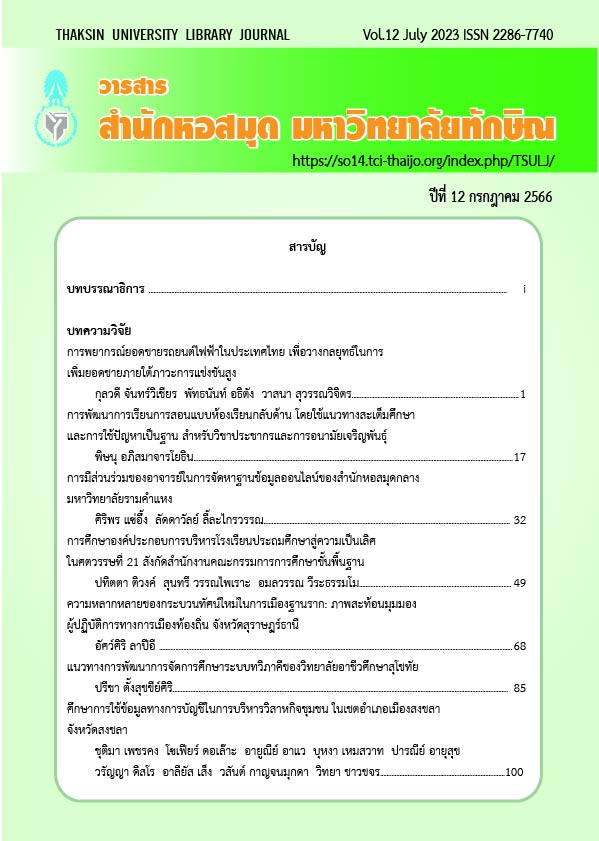Development of flipped classroom learning using STEM education approach and problem-based learning for population and reproductive health course
Keywords:
STEM Education, Flipped Classroom Learning, Problem-Based LearningAbstract
This research aims to develop STEM Education Model involved with flipped classroom learning context to strengthening problem-based learning. Researcher used online questionnaires to collect data with 218 students selected by using simple random sampling and used the summarized data for develop teaching model. And, taught with 2 student groups (60 students in each group) which involved students using normal teaching and students using the developed teaching model. The results were found that the samples thought that it should be develop STEM Education Model involved with flipped classroom learning context to strengthening problem-based learning at a high level ( =4.32). The teaching development was used the integration of STEM education to the course’s contents, the providing of learning environment or context by using flipped classroom learning, and the use of problem-based learning activities which was a combination between offline classroom and online classroom. The assessment of teaching model’s efficiency was pass the criterion (
=4.60). The pre-test and post-test of achievement scores of students using the developed teaching model were different at .05 signification level. The post-test of achievement scores between students using normal teaching and students using the developed teaching model were different at .05 signification level. Besides, Students had satisfaction to the teaching developed at a high level (
=4.60).
References
ณพงศ์ วรรณพิรุณ. (2559). รูปแบบการเรียนการสอนแบบสะเต็มศึกษาในสภาพแวดล้อมการเรียนรู้แบบห้องเรียนกลับด้านเพื่อเสริมสร้างทักษะความคิดสร้างสรรค์ทางวิทยาศาสตร์และเทคโนโลยี. วารสารการอาชีวะและเทคนิคศึกษา, 6(12), 84-96.
พรทิพย์ ศิริภัทราชัย. (2556). STEM Education กับการพัฒนาทักษะในศตวรรษที่ 21. วารสารนักบริหาร, 33(2), 49-56.
พิชิต ฤทธิ์จรูญ. (2545). หลักการวัดและประเมินผลการศึกษา. กรุงเทพฯ: เฮ้าส์ ออฟ เคอร์มีสท์.
พิษนุ อภิสมาจารโยธิน. (2562). ชีวสถิติเชิงพรรณนาและเชิงอนุมานเบื้องต้นสำหรับการวิจัย. กรุงเทพฯ: ทริปเพิ้ลเอ็ดดู เคชั่น.
พิษนุ อภิสมาจารโยธิน. (2563). การวิเคราะห์ปัจจัยเชิงสาเหตุที่มีอิทธิพลต่อการจัดการชีวิตของวัยรุ่นหญิง มารดาวัยรุ่น และครอบครัว. วารสาร BU Academic Review, 19(1), 48-61.
ภูวดล บัวบางพลู. (2554). การพัฒนาระบบบริหารจัดการการเรียนการสอนผ่านระบบเครือข่ายระดับอุดมศึกษา. SDU Res. J., 7(2), 1-17.
สถาบันส่งเสริมการสอนวิทยาศาสตร์และเทคโนโลยี. (2557). รู้จักสะเต็ม: STEM Education Thailand. สืบค้น 24 กันยายน 2663, จาก http://www.stemedthailand.org/?page_id=23%20
สุทธิดา จำรัส. (2560). นิยามของสะเต็มและลักษณะสำคัญของกิจกรรมการเรียนรู้ตามแนวสะเต็มศึกษา. วารสารศึกษาศาสตร์ มสธ., 10(2), 13-34.
สำนักงานคณะกรรมการการอุดมศึกษา. (2552). กรอบมาตรฐานคุณวุฒิระดับอุดมศึกษาแห่งชาติ พ.ศ.2552. กรุงเทพฯ: ผู้แต่ง.
Barbara, M., Wang, H., Xin, W., Young, V., & Emi, I. (2021). Impacts of attending an inclusive STEM high school: Meta-Analytic estimates from five studies. International Journal of STEM Education, 8(4), 1-19.
Barrows, H.S. (1996). Problem-based learning in medicine and beyond: A brief overview. New Directions for Teaching and Learning, (68), 3-12.
Ceylan, S., Zeynep, S.A., & Seyit, A.K. (2018). STEM skills in the 21st century education. Turkey: Bozok University.
National Research Council. (2012). A framework for K-12 science education: Practices, crosscutting concept, and core ideas. Washington, DC: National Academy Press.
Vasquez, J.A., Sneider, C., & Comer, M. (2013). STEM lesson essentials: Integrating science, technology, engineering, and mathematics. Portsmouth, NH: Heine- mann.
Wood, D.F. (2003). ABC of learning and teaching in medicine: Problem based learning. BMJ, 326(7384), 328-330.


